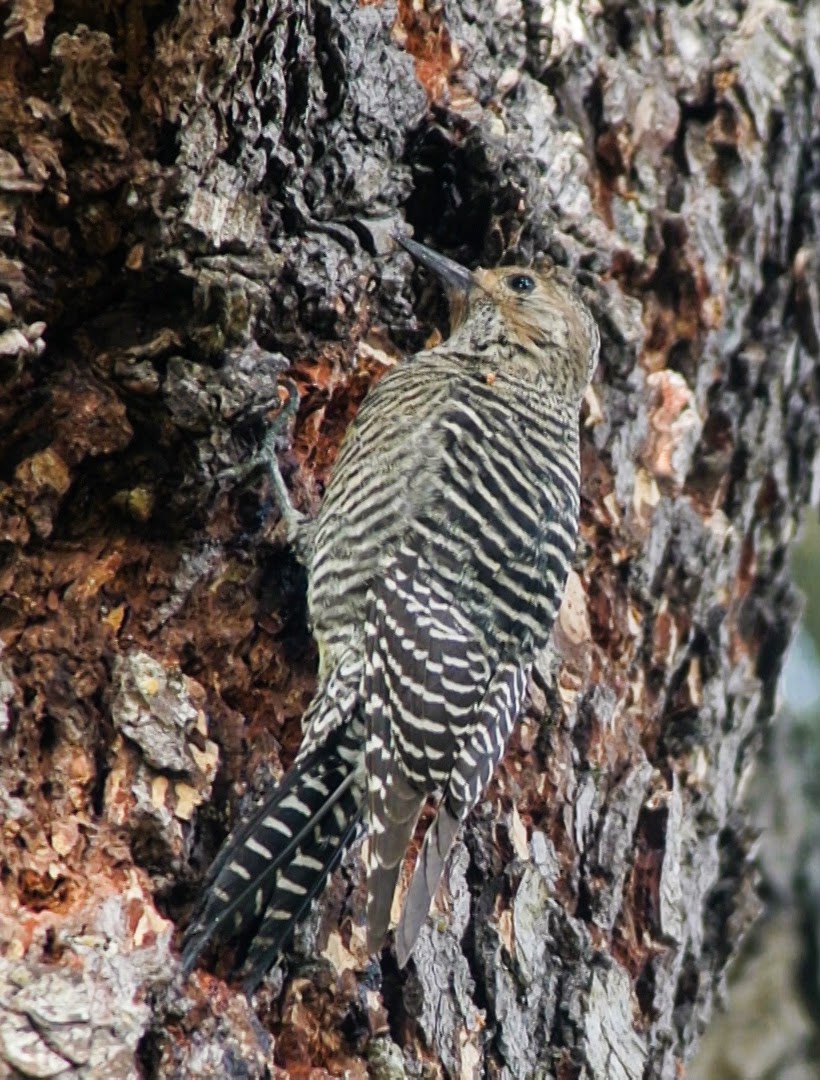I've always been fascinated by the woodpeckers and allies. The recent sighting of a female Williamason's Sapsucker in Santa Rosa prompted me to review my experience with the sapsuckers, genus Sphyrapicus.
The woodpeckers are in the diverse order of Picaformes, which includes beautiful tropical families Jacamars, Puffbirds, Barbets, Honey-guides and Toucans. The woodpeckers comprise the family Picadae, made up of about 28 genera and over 210 species worldwide. Many are tropical, and the majority are New World. In the U.S. we have about 22 species in 5 genera [Sibley Guide to Bird Life], among which are 9 species in genus Picoides and 6 species in genus Melanerpes. Genus Sphyrapicus has the 4 sapsuckers, and our 2 Flickers are in Colaptes. The Pileated Woodpecker is our only representative of the genus Dryocopus.
The woodpeckers are in the diverse order of Picaformes, which includes beautiful tropical families Jacamars, Puffbirds, Barbets, Honey-guides and Toucans. The woodpeckers comprise the family Picadae, made up of about 28 genera and over 210 species worldwide. Many are tropical, and the majority are New World. In the U.S. we have about 22 species in 5 genera [Sibley Guide to Bird Life], among which are 9 species in genus Picoides and 6 species in genus Melanerpes. Genus Sphyrapicus has the 4 sapsuckers, and our 2 Flickers are in Colaptes. The Pileated Woodpecker is our only representative of the genus Dryocopus.
Locally we have the Red-breasted Sapsucker, S. ruber, which occurs along the Pacific Coast from southern Alaska to California and Baja, but doesn't range very far to the east. Ours are usually the "southern" part of the cline, showing a bit less red on the head and face than those further north. First photo is a composite view of a male Red-breasted on a walnut tree in Volunteer Canyon, at ACR's Martin Griffin Preserve.
Here's another of the same bird, showing how neatly the holes have been drilled:
And one last male Red-breasted, taken at Lake Solano Park along the Putah River. Note the typical sapsucker white patch on the wing:
The Red-breasted Sapsucker, along with Yellow-bellied Sapsucker and the Red-naped Sapsucker made up a complex of closely related birds that were considered subspecies of the Yellow-Breasted until the 3 types were split and each was elevated to full species status in 1983. Some prefer to continue to think of those 3 as a "super-species", Sphyrapicus varius.
The Red-naped Sapsucker, S. nuchalis, has a rangemostly east of our coast, but is found here in small numbers each year. The male has more extensive red in the throat. This one was in oak woodlands north of Davis:
The Yellow-bellied Sapsucker, S. varius, breeds widely across Canada and winters in the southern half of the U.S. from Texas to the east coast. This one on a palm tree in Tarpon Springs, Florida. Note the similarity to the Red-naped, but less extensive red areas.
Williamson's Sapsucker is the fourth member of the genus Sphyrapicus, having diverged from the others in the more distant past.related. Sapsuckers are related to the genus Melanerpes (Acorn, Red-headed, Lewis's, Gila, Golden-fronted and Red-bellied Woodpeckers). [BNA #663a,Walters et. al.] Here's a marginal shot of the female Williamson's Sapsucker in Santa Rosa, rather high in the tree:
The rapid drilling of the bird made for mostly blurred photos, as you can see from a short movie:
Here's another of the same bird, showing how neatly the holes have been drilled:
And one last male Red-breasted, taken at Lake Solano Park along the Putah River. Note the typical sapsucker white patch on the wing:
The Red-breasted Sapsucker, along with Yellow-bellied Sapsucker and the Red-naped Sapsucker made up a complex of closely related birds that were considered subspecies of the Yellow-Breasted until the 3 types were split and each was elevated to full species status in 1983. Some prefer to continue to think of those 3 as a "super-species", Sphyrapicus varius.
The Red-naped Sapsucker, S. nuchalis, has a rangemostly east of our coast, but is found here in small numbers each year. The male has more extensive red in the throat. This one was in oak woodlands north of Davis:
Williamson's Sapsucker is the fourth member of the genus Sphyrapicus, having diverged from the others in the more distant past.related. Sapsuckers are related to the genus Melanerpes (Acorn, Red-headed, Lewis's, Gila, Golden-fronted and Red-bellied Woodpeckers). [BNA #663a,Walters et. al.] Here's a marginal shot of the female Williamson's Sapsucker in Santa Rosa, rather high in the tree:
The rapid drilling of the bird made for mostly blurred photos, as you can see from a short movie:
The male Williamson's Sapsucker look quite different from the female. We saw this one at the nest high on a campground tree at Yuba pass. Note the extensive black on the back. Unfortunately we can't see the yellow belly or the small red patch confined to the throat.
The first specimens of the female Williamson's Sapsucker were collected in 1849-1851 (John Bell). Cassin named the new species was Picus thyroideus. Common names used included Black-breasted Woodpecker and Brown-headed Woodpecker. In 1955, John Newberry collected a yellow-bellied black and white woodpecker and named it Williamson's Woodpecker, to honor Robert Stockton Williamson, the leader of an army survey team looking for a route for the railroad to go across the mountains. It wasn't until 1873 that these 2 woodpeckers (Brown-headed and Williamson's) were seen nesting as a pair and were determined to be the same species, albeit one with striking sexual dimorphism. Thus, the 2 species became one. Similar confusion attends the sapsucker' scientific name changes, with the genus changing from Picus to Melanerpes and finally to Sphyrapicus. (See Birds of North America Online, #289, Dobb's et. al.).









No comments:
Post a Comment